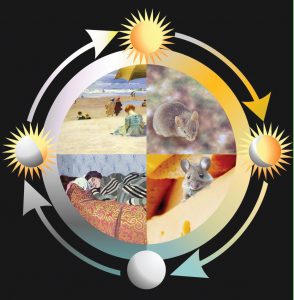Exposure to UV radiation triggers DNA lesions that can lead to skin cancer, the most common type of cancer in the United States. Previous studies in mice have shown that levels of a protein called XPA, involved in repairing UV-induced DNA lesions, waxes and wanes with the time of day. Shobhan Gaddameedhi et al. found that the protein’s level and activity in mouse skin cells are at their lowest at 4 AM and their highest at 4PM.

Title: Time of UV exposure might influence skin cancer onset
Authors: Shobhan Gaddameedhi, Christopher P. Selby, William K. Kaufmann, Robert C. Smart, and Aziz Sancar
Journal: Proceedings of the National Academy of Sciences
Issue: November 15, 2011 – vol. 286, no. 46, 18567-18568
About the Article: The authors exposed two groups of mice to UV radiation—one at 4 AM and the other at 4 PM—and monitored the onset of skin cancer. Mice irradiated when the repair activity was at its lowest developed tumors much faster and at fivefold higher frequency compared with mice exposed to UV when the protein’s repair function was at full throttle. When the authors repeated the experiment in a strain of mice lacking two key components of the circadian clock, the time of UV exposure tracked neither the protein’s repair activity nor the onset of skin cancer, suggesting that circadian control of the XPA protein might influence skin cancer rates. Because mouse and human circadian clocks are similar, the time of UV exposure might likewise determine its cancer-causing potential in people, according to the authors.
Group Page: Aziz Sancar Lab

